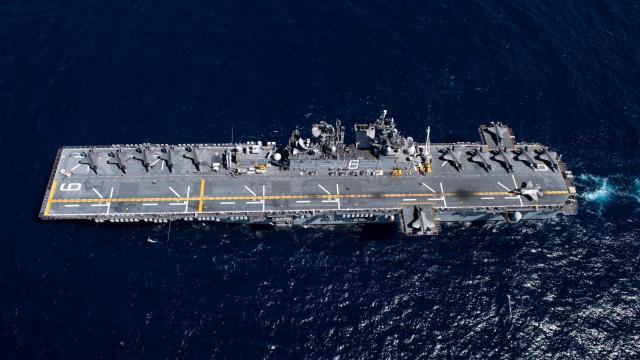The U.S. Marines are testing loading an amphibious assault ship with a baker’s dozen of F-35B Lightning fighter jets. The result is what the Navy and Marines call a “Lightning Carrier,” and it could be a glimpse into the future of naval aviation.
While Lightning Carriers may not replace the full-size, full-price supercarriers the Navy is accustomed to, they represent an affordable alternative for contingencies short of World War III.
Earlier this month, the amphibious assault ship USS America was photographed off the coast of California with 13 F-35B Joint Strike Fighters on her flight deck. A single grey navy MH-60 helicopter, likely embarked for search and rescue tasks, sits forward of the island.
USS America resembles a stubby aircraft carrier, with a full-length flight deck, island superstructure, and aircraft elevators. America is actually an amphibious assault ship, meant to send Marines ashore by air and sea, and carry a small number of fighter jets for close air support. Ships like America typically carry six Lightnings as part of a Marine Expeditionary Unit, an air-ground fighting force built around an infantry battalion and a reinforced squadron of helicopters, tilt rotors, and fighter jets.
America and the upcoming Tripoli are slightly different than their sister ships in the Wasp class. Unlike older ships, which include a so-called well deck to carry hovercraft, amphibious vehicles, and landing craft, the newer ships are aviation-centric. The newer ships give up their ability to land Marines and their vehicles by sea, using that space to carry more aviation fuel, spare parts, and aircraft munitions.
This change, invisible from the outside, makes America and Tripoli great candidates to act as ad hoc carriers. By giving up other aircraft that make up part of a MEU, like the MV-22 Osprey and CH-53E Sea Stallion, USS America can fit up to 13 F-35s onboard. Secretary of the Navy Richard Spencer, quoted in USNI News suggests she can carry even more. At a Washington D.C. think tank event, Spencer reportedly said:
“About nine months ago I was looking at … USS America, a terrific amphib ship, and said, you know what, why don’t we load this thing up with F-35 Bravos, put 20 F-35 Bravos on this, and make it quote/unquote a lightning carrier.”
Lightning Carriers could prove very useful in the Navy/Marine Corps toolbox. There are plenty of situations where a smaller carrier, loaded with vertical takeoff and landing jets, would be a better fit than a full-sized carrier. A Lightning Carrier could sit off the coast of Libya, Somalia, or some other country where the threat to the fleet is minimal and provide a potent source of airpower. A smaller carrier is a cheaper carrier.
Lightning Carriers also provide capability against higher-end threats like Russia and China. A Lightning Carrier could sail alongside a full-size carrier like the USS Abraham Lincoln, providing up to twenty more fighter jets for air operations. Their flexibility makes countering them a headache: even if an adversary knew an America-class ship was soon going to sea, it would be difficult to know if it was going to sea as an “amphib” or carrier until it cast off from the pier. Finally, the vertical takeoff and landing nature of the F-35B means that a Lightning Carrier could sail through a contested area and actually leave its jets behind on an ad hoc airstrip, complicating the enemy’s ability to keep track of—or defeat—both.
Lightning Carriers have disadvantages. They carry less than half the fighter jets of a full-sized carrier. They can’t carry the E-2D Hawkeye airborne early warning and command and control aircraft, the E/A-18G Growler electronic warfare jet, or any aircraft with aerial refuelling capability. This impacts their ability to conduct certain types of missions, reducing the detection and operating ranges of the fleet at a time the Navy is trying to increase both.
Lightning Carriers do have one trump card, and that’s off the battlefield: USS America cost taxpayers just $US3.4 ($5) billion. The USS Gerald R. Ford, on the other hand, cost $US13 ($19) billion and climbing. USS America can embark up to 20 F-35Bs and at least one SH-60 Seahawk helicopter; Ford on the other hand will embark roughly 75 aircraft, including 20 of the Navy’s F-35C carrier-based variants. The Pentagon could buy four America-class ships for the price of USS Ford, teaming smaller carriers with bigger ones.
Critics of the plan will say that you get what you pay for, even with the Ford’s horrendous cost, and they’re right. More ship and more planes equals more capability. But four for the price of one is an awfully compelling deal, and even assuming the cost of USS John F. Kennedy, the second Ford-class ship comes down three for one still sounds pretty good. Lightning Carriers won’t replace full-size flat-tops, but they could complement them at sea. And if the U.S. Navy can’t get costs down for on the Ford-class supercarriers, Congress could force the service to buy cheaper alternatives.
